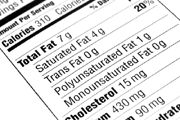Food Labels: Understanding Food Labels

You can gain a lot of information about a food and its affect on your body by simply knowing how to read the label. While label reading may come as a second nature to some, others may find it to be nothing more than an unnecessary headache.
Before we get into it, its good to get a brief history and understanding about food labels. Nutrition facts labels were created in the USA by the FDA (Food and Drug Administration) and in 1990 the Nutrition Labeling and Education Act were put into effect. This meant that the consumer would have access to the nutritional content of a specific food in order to help them gain a better understanding of what they were eating.
What will the Nutrition Label give me?
From reading the nutrition label on foods you will be able to identify the exact amount of fat (including saturated, trans fats, unsaturated as well as poly and monounsaturated fat), protein and carbohydrates a specific food contains. You will also know the amount of sugar, calories, cholesterol, sodium and potassium that the product has. Vitamins, minerals and other ingredients can also be found on the nutrition label.
A food label will give you the nutrients based on the contents of a serving, and in South Africa, we also get a breakdown of these nutrients per 100 grams, making it quick and easy to compare two different foods.
What's in a food label?
Calories
This will give you the exact number of calories that the specific food has. Calories provide a measure of how much energy is obtained from a specific food.
1 gram of protein contains 4 calories
1 gram of carbohydrates contains 4 calories per gram
1 gram of fat contains 9 calories per gram
1 gram of alcohol contains 7 calories per gram
On a food label, the combined nutrients are combined in order to give you a breakdown of exactly how many calories you are eating.
Nutrients
The nutrients contained within a specific food are also listed in precise measurements. From this list you are able to see exactly how many grams of carbs, protein, fats, sugars etc you are getting by eating that specific food.
Decoding the food label lingo
Food manufacturers are getting smart and adding fancy words like "low fat", "light" and "sugar free" etc. to their packaging. The reason? To try and 'hook' consumers on the belief that that specific product is either low in fat or fat free. But just because it says it's fat free, doesn't mean it has zero fat content.
Here is a quick guide to help you decode the food label lingo:
- Fat/calorie free: Fewer than 5 calories/grams of fat per serving.
- Cholesterol free: Less than 2mg of cholesterol.
- Low fat/calorie: No more than 40 calories per serving and no more than 3 grams per serving.
- Sugar free: Less than 0.5 grams of sugar per serving.
- Reduced: Product contains 25% or less of a nutrient than the regular product.
- Light: Product's calorie content has been reduced by at least ½ of the regular product or fat content has been reduced by ½ of the regular product.
- Lean: Contains fewer than 10 grams of fat and less than 4 grams of saturated fat.
- Extra lean: Contains fewer than 5 grams of fat and fewer than 2 grams of saturated fat.
Author: Dimi Ingle
Copyright: Remedium. This article may not be copied, in whole or in part, without the written consent of Remedium.
|